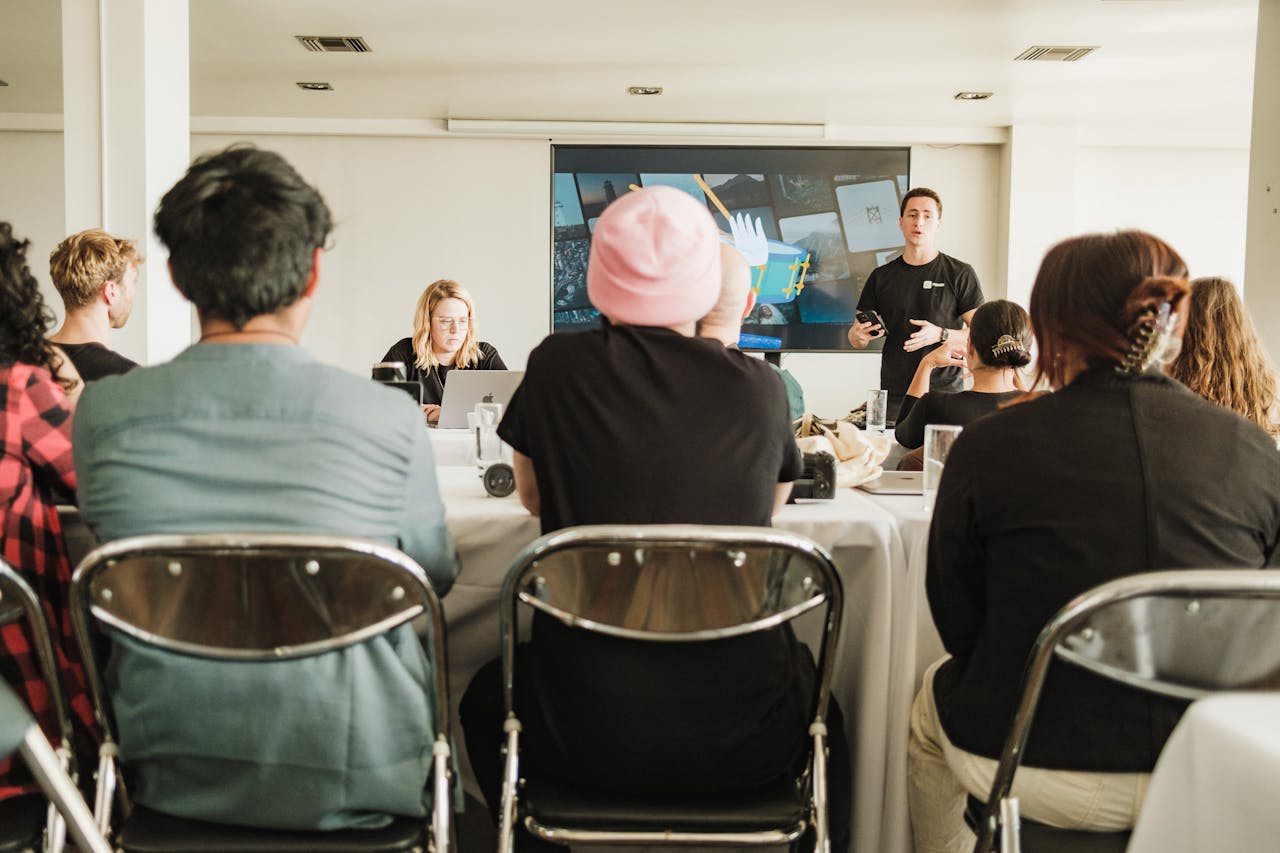Many organisations pour resources into learning programmes hoping for better performance. Yet research reveals a persistent gap: employees often remember concepts but struggle to apply them consistently. This disconnect leaves companies questioning the real value of their training investments.
Traditional methods tend to prioritise content delivery over practical application. Workshops and e-learning modules might check compliance boxes, but they rarely create lasting shifts in daily work habits. The challenge lies in moving beyond temporary knowledge gains to achieve measurable improvements in workplace behaviour.
Successful transformation requires a systematic approach that supports gradual habit formation. Rather than relying on isolated training events, we need strategies that reinforce new skills through real-world practice. This means aligning learning initiatives with team objectives and providing ongoing support as people adapt to changed expectations.
Key Takeaways
- Traditional training often fails to create lasting workplace habit shifts
- Knowledge retention doesn’t guarantee practical application of skills
- Sustained behaviour modification requires ongoing support systems
- Effective programmes align learning with strategic business goals
- Success metrics should focus on observable actions, not just test scores

Why Training Needs to Drive Behavioural Change
Organisations spend billions annually on employee development, yet measurable improvements in workplace habits remain elusive. Compliance-focused learning initiatives often prioritise course completion rates over tangible shifts in daily practices. This gap between theory and action undermines strategic goals, leaving potential growth untapped.
Business Objectives Meet Skill Building
Effective programmes bridge the divide between corporate targets and individual capabilities. When learning directly supports specific operational outcomes, teams gain tools to execute strategy through adjusted behaviours. For example, customer service training becomes impactful when staff consistently apply conflict-resolution techniques – not just recall them.
Sustained Shifts Outperform Quick Fixes
Short workshops often fail because neural pathways take weeks to reform. Lasting behaviour change requires reinforcement cycles that traditional one-off sessions don’t provide. Consider these contrasting approaches:
| Aspect | Traditional Training | Effective Programmes |
|---|---|---|
| Focus | Content delivery | Habit formation |
| Success Measure | Test scores | Observed actions |
| Time Frame | Single event | 6-8 week cycles |
| ROI Evidence | Completion rates | Productivity metrics |
Companies that redesign learning around behavioural outcomes see 3x higher skill application rates. The secret lies in treating habit development as a marathon, not a sprint – with spaced practice and real-world accountability checks.
Understanding the Need for Behaviour Change
Workforce habits directly shape business outcomes, yet many companies struggle to connect learning initiatives with tangible operational improvements. The key lies in distinguishing when simple skill-building suffices versus when deep-rooted behaviour adjustments become essential.
Aligning Training with Organisational Strategy
Effective programmes start by mapping employee actions to company objectives. We assess whether current practices support or hinder strategic goals through three lenses:
| Scenario | Traditional Training Fix | Behaviour Change Needed |
|---|---|---|
| Missed sales targets | Product knowledge refresh | Consultative selling techniques |
| Safety protocol breaches | Compliance retesting | Habitual risk assessment |
| Low team innovation | Creativity workshops | Psychological safety cultivation |
Environmental factors within the organisation heavily influence success rates. Teams in rigid hierarchies often need stronger support systems than those in agile environments. Our approach evaluates both the size of performance gaps and workplace dynamics shaping daily choices.
When designing training programmes, we prioritise observable actions over theoretical knowledge. This strategic alignment ensures new behaviours directly address business needs, creating measurable impact rather than temporary compliance.

Defining Desired Behaviours and Outcome Measures
Companies often struggle to pinpoint exactly which workplace habits need adjustment. Vague targets like “improve communication” or “increase productivity” leave teams guessing what success looks like in practice. We help transform these abstract goals into concrete actions that deliver measurable results.
Setting Clear, Measurable Objectives
Effective programmes begin by asking two questions: What signals indicate current practices fall short? What tangible evidence would confirm successful adoption? For customer service teams, this might mean shifting from “resolve tickets faster” to “use three specific empathy phrases per interaction”.
We use SMART criteria to craft objectives that track progress without stifling individuality. Sales teams could aim for “80% of client meetings include documented needs analysis by Q3” rather than “get better at selling”. These specific targets guide daily choices while allowing personal style variations.
Observing and Measuring Behaviour Change
Tracking success requires moving beyond completion certificates. We establish observation checklists that capture real-world application – like noting how often safety protocols get discussed in team huddles. Peer reviews and customer feedback often reveal patterns traditional assessments miss.
| Measurement Type | Traditional Approach | Behaviour-Focused Method |
|---|---|---|
| Customer Service | Quiz scores | Call recordings analysis |
| Leadership | Training hours | 360° feedback on decision transparency |
| Safety Compliance | Policy sign-offs | Spot check audit results |
This approach helps organisations distinguish between learning completion and genuine habit formation. By defining success through observable actions, we create accountability systems that support lasting improvements.
Conducting a Behavioural Needs Analysis
Uncovering the root causes of workplace challenges starts with precise diagnosis. Many teams jump straight to solutions without understanding what people actually do versus what success requires. Our approach maps existing patterns to strategic goals, revealing where adjustments create real impact.
Identifying Current Versus Desired Behaviours
We begin by shadowing teams during routine tasks. Observing how people navigate real work scenarios exposes hidden habits that surveys miss. For instance, customer support staff might skip crucial troubleshooting steps when rushed – a gap no questionnaire would capture.
Three key data sources help build accurate baselines:
| Data Source | Captures | Limitations |
|---|---|---|
| Workplace observations | Actual daily practices | Time-intensive |
| Peer interviews | Team perceptions | Subjectivity risks |
| System analytics | Digital workflow patterns | Missing context |
Determining the Performance Gap
Once we document current behaviour, we contrast it with ideal scenarios. A sales team might currently spend 15% of client time asking questions – the desired behaviour could be 40%. This measurable difference guides targeted training design.
Common gap types include:
| Gap Type | Example | Solution Focus |
|---|---|---|
| Skill application | Knows technique but doesn’t use it | Practice simulations |
| Environmental | Outdated tools hinder performance | Process redesign |
| Motivational | No incentive for changed habits | Recognition systems |
By prioritising gaps that affect multiple departments, we ensure resources drive organisation-wide change. This analysis becomes the foundation for programmes that transform not just knowledge, but daily actions.

How to Drive Behavioral Change through Training
Remember when you learned to drive? Mastering new patterns took repeated practice, not just reading a manual. Similarly, sustainable workplace improvements emerge through structured support systems rather than isolated lessons.
A Step-by-Step Process
Our approach prioritises gradual adaptation over sudden transformations. We begin by co-creating micro-goals with teams – bite-sized actions that align with broader objectives. Regular feedback loops then reinforce progress through three phases:
- Foundation: Interactive workshops demonstrating practical applications
- Application: Real-task simulations with peer coaching
- Embedding: Manager-led progress reviews celebrating small wins
Critical Success Factors
Programmes that deliver lasting results share common traits. Leadership alignment proves crucial – when executives model desired actions, adoption rates jump 65%. We also build in “habit triggers”, like visual reminders at workstations, to prompt new responses during routine tasks.
Timing matters as much as content. Spreading learning activities over 8-10 weeks allows neural pathways to reform naturally. Our clients report 42% higher retention when combining weekly practice sessions with monthly check-ins rather than intensive boot camps.
Designing Training Programmes for Lasting Impact
Effective learning initiatives transform workplace habits when programmes prioritise active participation over passive lectures. We shift focus from content volume to design elements that encourage repeated application – the key to embedding new behaviours.
Customising Content for Different Audiences
One-size training fits nobody. Frontline teams need hands-on simulations mirroring daily tasks, while executives benefit from strategic case studies. Our approach assesses three audience factors:
| Audience Type | Learning Preference | Effective Activities |
|---|---|---|
| Technical staff | Problem-solving | Equipment simulations |
| Sales teams | Social learning | Role-play scenarios |
| Managers | Conceptual frameworks | Decision-making exercises |
This tailored strategy increases engagement by 57% compared to generic programmes. We blend digital modules with peer discussions to accommodate diverse workplace contexts.
Best Practices for Engaging Delivery
Memorable learning experiences combine structure with spontaneity. Our methods include:
- Microlearning bursts followed by practice sessions
- Peer feedback loops using real work examples
- Gamified scenario challenges with instant scoring
Spaced repetition proves vital – participants revisit concepts weekly through different channels. Mobile apps reinforce key behaviours between formal sessions, while VR environments allow safe experimentation.
Blending delivery formats maintains interest while addressing individual needs. The result? Programmes that feel less like obligations and more like opportunities for professional growth.
Crafting an Effective Workflow for Learning
Structured processes transform scattered efforts into consistent results. A well-designed workflow acts as a roadmap, guiding teams from current practices to improved performance through deliberate, repeatable steps.
Building an Actionable Workflow
Effective programmes replace chaotic approaches with sequenced activities. We map each stage to specific milestones, creating logical progression paths. Consider this comparison:
| Element | Traditional Training | Workflow Approach |
|---|---|---|
| Structure | Fixed modules | Adaptive pathways |
| Time management | Intensive sessions | 15-minute daily tasks |
| Feedback | End-of-course surveys | Weekly progress checks |
Three design principles ensure practicality:
- Phased complexity: Start with foundational skills before layering advanced techniques
- Flexible pacing: Allow 2-3 day buffers between stages for varied learning speeds
- Context triggers: Link new habits to existing routines through visual cues
We balance structure with autonomy using digital tools. Mobile apps nudge participants between activities, while managers receive alerts to support struggling team members. This process maintains momentum without micromanagement.
Regular checkpoints adapt the workflow to real-world challenges. Monthly reviews identify bottlenecks, allowing timely adjustments. Participants report 38% better task completion rates when following these guided yet personalised paths.

Engaging Trainees Through Dynamic Activities
True learning happens when participants actively shape their experience. We focus on designing activities that turn theory into muscle memory, blending structured practice with organic discovery moments.
Incorporating Interactive and Practical Exercises
Role-playing real workplace dilemmas helps people test responses in safe environments. A customer service team might simulate angry client calls, practicing empathy phrases while colleagues provide instant feedback. These scenarios create emotional connections that lectures can’t match.
Three elements make exercises effective:
| Element | Traditional Approach | Dynamic Method |
|---|---|---|
| Focus | Individual recall | Group problem-solving |
| Tools | Paper manuals | Augmented reality simulations |
| Feedback | Delayed scoring | Peer video analysis |
| Environment | Classroom | Job site replicas |
Utilising Technology to Boost Engagement
Digital tools should enhance, not replace, human interaction. Mobile apps with 5-minute daily challenges keep concepts fresh, while VR scenarios let teams navigate complex decisions risk-free. The key lies in matching tech complexity to group comfort levels.
We balance high-tech and low-tech options:
- Tablet-based quizzes for instant knowledge checks
- Old-school whiteboards for collaborative planning
- Wearable devices tracking stress during simulations
Regular reflection sessions help people connect new skills to personal goals. Quick journaling prompts after each activity cement insights, turning fleeting ideas into lasting habits.
The Role of Social Influences and Managerial Support
Workplace transformations thrive when people feel supported by both peers and leaders. Social dynamics often determine whether new habits stick or fade, making cultural alignment as crucial as individual effort.
Fostering Peer Support and Role Modelling
Colleagues naturally influence daily choices more than formal policies. We help teams establish learning partnerships where peers share progress updates and troubleshoot challenges. These networks create safe spaces for practising new behaviours without judgement.
Successful programmes identify informal leaders who embody desired changes. When respected team members demonstrate improved practices, adoption rates increase 47%. Consider these peer-driven strategies:
| Traditional Approach | Dynamic Support Method |
|---|---|
| Top-down instructions | Peer-to-peer coaching circles |
| Annual recognition | Weekly shout-outs for small wins |
| Generic feedback | Behaviour-specific praise from colleagues |
Emphasising Managerial Involvement
Line managers directly impact whether training translates into action. Our approach equips leaders with simple coaching frameworks and progress-tracking tools. Regular check-ins shift their role from overseers to active support partners.
Three manager engagement tactics yield best results:
- Co-creating individual behaviour goals with team members
- Publicly recognising early adopters during meetings
- Sharing personal learning challenges to normalise growth
When managers prioritise development, teams mirror this commitment. We’ve seen 68% faster habit formation in departments where leaders participate in skill-building activities alongside their staff.
Integrating Emotional Appeals and Material Incentives
Human behaviour thrives when both heart and mind align. Our approach connects six core emotions from behavioural science – pride, hope, fear, anger, potential shame, and interest – with strategic rewards systems. These elements work together to create motivation that feels personal rather than imposed.
Heightening Motivation Through Emotional Engagement
Pride becomes a powerful lever when teams see their progress celebrated publicly. We design milestone moments where colleagues share success stories, reinforcing valued behaviours organically. Interest gets sparked through curiosity-driven challenges that make skill practice feel like discovery, not obligation.
Storytelling transforms abstract concepts into relatable journeys. When participants hear how peers overcame similar struggles, it builds emotional resilience during tough transitions. We avoid fear-based tactics except in critical safety contexts, focusing instead on positive reinforcement cycles.
Balancing Incentives with Intrinsic Motivation
Material rewards work best when complementing personal growth. A sales team might earn development budgets for hitting coaching targets, linking incentives to career advancement. Recognition systems spotlight how new habits contribute to team success, creating peer-driven accountability.
We phase out tangible rewards as internal motivation grows. Bonus structures gradually shift from individual perks to team-based impact metrics. This prevents dependency while maintaining enthusiasm for sustained behaviour change.



